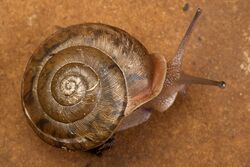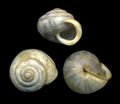Biology:Polygyridae
| Polygyridae | |
|---|---|

| |
| A live individual of Neohelix dentifera | |

| |
| Three views of a shell of Mesodon thyroidus from W. G. Binney, 1878[1] | |
| Scientific classification | |
| Domain: | Eukaryota |
| Kingdom: | Animalia |
| Phylum: | Mollusca |
| Class: | Gastropoda |
| Subclass: | Heterobranchia |
| Order: | Stylommatophora |
| Suborder: | Helicina |
| Infraorder: | Helicoidei |
| Superfamily: | Helicoidea |
| Family: | Polygyridae Pilsbry, 1895 |
| Genera | |
|
See text | |
Polygyridae is a family of air-breathing land snails, terrestrial pulmonate gastropod mollusks in the superfamily Helicoidea.[2]
The Polygyridae make up a significant proportion of the land snail fauna of eastern North America, and are also found in western North America, northern Central America, and are present on some Caribbean islands. The definitive reference to the group is Henry Pilsbry's 1940 monograph.[3]
Anatomy
This snail family is distinguished from other gastropods on the basis of several anatomical features: They have no dart apparatus (see love dart), the muscles which allow the eyes and pharynx to be retracted are united into a single band, and the jaws are ribbed.[4]
In this family, the number of haploid chromosomes lies between 26 and 35 (according to the values in this table).[5]
Taxonomy
According to the Taxonomy of the Gastropoda (Bouchet & Rocroi, 2005) this family consists of the following subfamilies and tribes:
- Subfamily Polygyrinae Pilsbry, 1895
- tribe Allogonini Emberton, 1995
- tribe Ashmunellini Webb, 1954
- tribe Polygyrini Pilsbry, 1895
- subtribe Mesodontina Tryon, 1866
- subtribe Polygyrina Pilsbry, 1895
- subtribe Stenotrematina Emberton, 1995
- Subfamily Triodopsinae Pilsbry, 1940
Genera
This family is defined by an absent diverticulum and absent stimulatory organ. The two subfamilies, Polygyrinae and Triodopsinae, are distinguished on the basis of reproductive anatomy.[6][7][8] As some species in the subfamily Polygirinae show a penial appendage. This family is monophyletic.[9]
Pilsbry[3] uses the generic names Allogona, Ashmunella, Giffordius, Mesodon, Polygyra, Praticolella, Stenotrema, Trilobopsis, Triodopsis, and Vespericola. The remaining names listed here have either been elevated from Pilsbry's subgenera since 1940, or newly created.
Subfamily Polygyrinae:
- Appalachina
- Daedalochila
- Euchemotrema
- Fumonelix
- Giffordius
- Hochbergellus
- Inflectarius
- Linisa
- Lobosculum
- Mesodon
- Millerelix
- Patera
- Polygyra
- Praticolella
- Stenotrema
- Trilobopsis
Shells of species within the Polygyrinae
Polygyra septemvolva volvoxis
Subfamily Triodopsinae:
Shells of species within the Triodopsinae
Ashmunella levettei angigyra
Cryptomastix mullani clappi
References
- ↑ Binney, William G. (1878). The Terrestrial Air-Breathing Mollusks of the United States and Adjacent Territories of North America. Vol. 5 (plates). Bull. Mus. Comparative Zool., Harvard. Plate 11.
- ↑ MolluscaBase eds. (2021). MolluscaBase. Polygyridae Pilsbry, 1895. Accessed through: World Register of Marine Species at: http://www.marinespecies.org/aphia.php?p=taxdetails&id=993919 on 2021-02-11
- ↑ 3.0 3.1 Pilsbry, Henry A. 1940. Land Mollusca of North America (North of Mexico). Acad. Nat. Sci. Philadelphia, Monograph 3, vol. 1(2): 575-994.
- ↑ Pilsbry, Henry A. 1939. Land Mollusca of North America (North of Mexico). Acad. Nat. Sci. Philadelphia, Monograph 3, vol. 1(1): 1.
- ↑ Barker G. M.: Gastropods on Land: Phylogeny, Diversity and Adaptive Morphology. in Barker G. M. (ed.): The biology of terrestrial molluscs. CABI Publishing, Oxon, UK, 2001, ISBN:0-85199-318-4. 1-146, cited pages: 139 and 142.
- ↑ Pilsbry, H. A. 1940. Land Mollusca of North America (North of Mexico). Acad. Nat. Sci. Philadelphia Monograph 3, 1(2): 576.
- ↑ Emberton, K. C. 1991. The genetic, allozymic and conchological evolution of the tribe Mesodontini. Malacologia 33 (1-2): 71-178
- ↑ [1] Polygyridae at ITIS (Integrated Taxonomic Information System); accessed 18 Dec. 2007.
- ↑ Emberton, K. C. (1991). "Polygyrid relations: a phylogenetic analysis of 17 subfamilies of land snails (Mollusca: Gastropoda: Stylommatophora)". Zoological Journal of the Linnean Society 103 (3): 207–224. doi:10.1111/j.1096-3642.1991.tb00903.x. http://www3.interscience.wiley.com/journal/119842427/abstract.
External links
Wikidata ☰ Q3073130 entry
 |

















